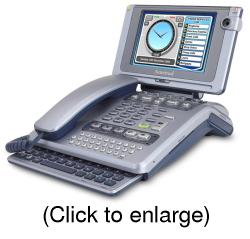Linux device aims to become first mass-market videophone
Sep 21, 2004 — by LinuxDevices Staff — from the LinuxDevices Archive — 31 views [Updated Sep. 23] — Amstrad has used embedded Linux to build an inexpensive videophone. The £100 (about $180) Amstrad E3 enables users to send email and SMS/MMS messages, surf the Web, and videoconference with other E3 users over a 56K modem connection to a UK service provider.
[Updated Sep. 23] — Amstrad has used embedded Linux to build an inexpensive videophone. The £100 (about $180) Amstrad E3 enables users to send email and SMS/MMS messages, surf the Web, and videoconference with other E3 users over a 56K modem connection to a UK service provider.
(Click for larger view of Amstrad E3)
E3 features include:
- Optional videoconferencing with other E3 users at the touch of a button. Includes accept/decline confirmation screen, and single and dual-screen [screenshot] modes.
- Email/Fax client [screenshot] through Amserve service, includes email notification, remote Webmail and support for photo and voice attachments
- Web access through the “Amsurf” portal [screenshot]
- SMS/MMS message client [screenshot] lets users send text (up to 160 characters) and multimedia messages to mobile phone users. The SMS (text message) client can also be configured (in conjunction with optional Caller Display) to autorespond to messages from specific mobile phones.
- A “photosend” client is included [screenshot] that supports capturing a number of photos, and then selecting one to send in an email or MMS message
- Polyphonic ringtone downloads work in conjunction with an optional Caller Display subscription to let users assign distinctive rings to specific callers or, in households with a shared phone, to specific lists of contacts
- A high contrast color LCD screen supporting 480 x 320 resolution [image]
- Games, including arcade, puzzle, and shooter games, which work with an included game pad [image]
- Digital answering machine supports remote access (but not, apparently, customized outgoing messages for specific callers)
- Full-duplex handsfree (speakerphone) operation
 The E3 is based on a dual core Texas Instruments OMAP SoC (system on chip) with RISC and DSP cores clocked at 150MHz. It has 32MB of Flash, and 32MB of SDRAM. I/O ports include a USB port, which could be used in the future to expand the device with support for WiFi or a broadband connection.
The E3 is based on a dual core Texas Instruments OMAP SoC (system on chip) with RISC and DSP cores clocked at 150MHz. It has 32MB of Flash, and 32MB of SDRAM. I/O ports include a USB port, which could be used in the future to expand the device with support for WiFi or a broadband connection.
The operating system includes a 2.4.18 Linux kernel, with 2.6 under consideration for a future version. However, according to Amstrad spokesperson Dave Fraser, no other open source software was used in the device.
According to Amstrad, using MontaVista Linux helped keep costs down on the innovative E3 videophone. “Thanks, in part, to MontaVista Linux, we can offer this full featured phone for the home, to our customers at a very reasonable cost. At a retail price of around £99 the Amstrad E3 is a very compelling proposition and is a significant step towards bringing video phone functionality to the mass market,” said Simon Sugar, Amstrad commercial director.
MontaVista's UK president Ian Graham added, “Consumer devices, such as the Amstrad E3 videophone, are integrating more functionality and new features. To make these devices easy-to-use for consumers, the underlying software needs to be very sophisticated.”
Amstrad was founded 35 years ago by Alan Sugar, and was among the first companies in the world that sold computers to home users.
The phones are currently available for £179 per pair from select British retailers. An email session on the Amstrad E3 currenctly costs 15 pence (plus local call rate per minute). One session allows you to send multiple emails, as well as collect and receive all waiting email. Additional charges include (current at time of printing):
- Video calling - 50 pence per call - plus the cost of the phone call
- Surfing - 5 pence per minute at ALL times
- Photo send - 25 pence per email with photo attachment
- MMS - £1.00 per message sent
- SMS - 50 pence per message sent
- Games - Costs vary and can be viewed on screen prior to ordering
- Polyphonic ringtones - £1.50 per minute and last approximately 2 minutes 40 seconds
- Fax – £1.00 per fax message sent
This article was originally published on LinuxDevices.com and has been donated to the open source community by QuinStreet Inc. Please visit LinuxToday.com for up-to-date news and articles about Linux and open source.